Al Muizz Street and Khan Al Khalili, Cairo, Egypt
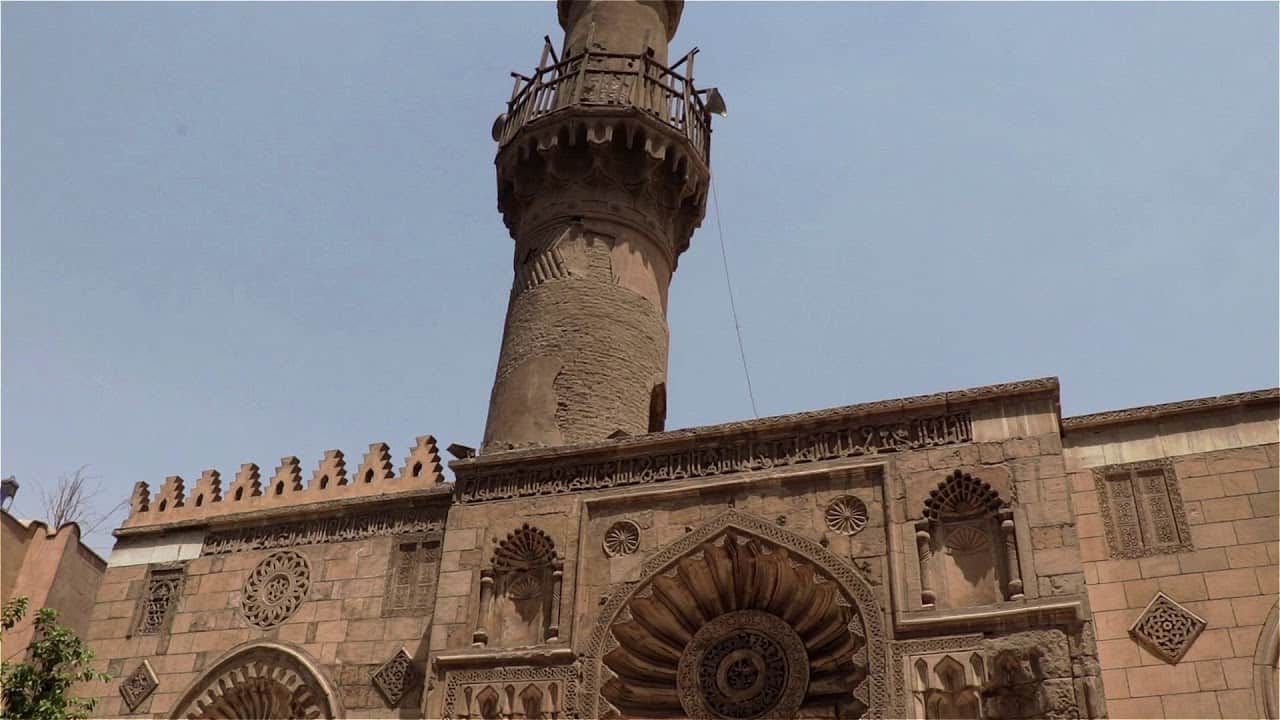
Updated On: April 18, 2024 by Dina Essawy
Cairo is one of the largest cities in Africa and one of the richest cities of cultural spots and monuments. From Ancient Egypt to Islamic and Coptic eras, the streets of the capital have witnessed grand civilizations which passed by the city and left their marks. The most famous of all the streets in Cairo is Al Muizz Street. It’s an open-air museum in the heart of the old city. There are plenty of unique activities one can do there. It’s actually considered as one of the most vibrant meetup spots in Cairo. That should totally be on the top of your must-do list when you visit Egypt. Let’s take a tour around the fascinating spots in Al Muizz Street.
The Geography of Al Muizz Street
The street is named after named after the fourth Fatimid Caliph Al-Mu’izz li-Deen Illah the Fatimid. According to a study conducted by the United Nations, Al Muizz Street hosts the biggest collection of medieval constructions in the whole Islamic world.
The street lies in the heart of old Cairo and is acting as a connection between different historical and significant areas around the area. The famous Al Muizz Street is expanding from Bab Al Futuh to Bab Zuweila (both Bab Al Futuh and Bab Zuweila are two of the only three remaining gates in the walls of Old Cairo). There you’ll find many stalls and markets located in Al Azhar Street and Al Ghuriya Complex nearby.
For people to have a one of a kind experience, it was ordered, on April 24, 2008, it was ordered that Al Muizz Street will be a pedestrian spot from 8 am to 11 pm. The spot of Al Muizz Street along with the surrounding areas are very rich of many Tulunid, Mamluk and Fatimid monuments.
While strolling around the street, you’ll meet a variety of historic constructions including mosques, houses, schools. In addition to the historical constructions, Al Muizz Street has plenty of shops where you can buy authentic and handmade souvenirs. And, of course, is a is one of the most perfect spots for some nice and unique pictures.
Khan Al Khalili
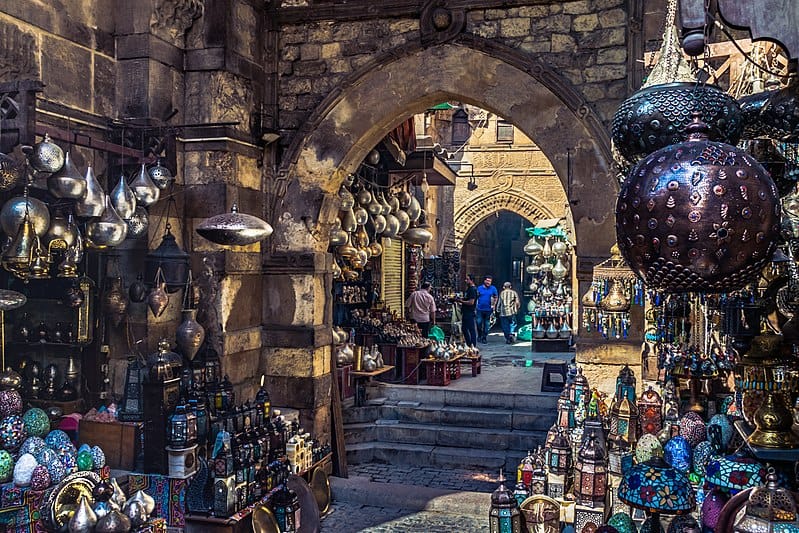
Established in the 14th century, Khan Al-Khalili in Old Cairo has always been an important district for cultural and economic activities. As a part of its charm and historical significance, many artists and writers have featured Khan Al Khalili in their works. One great example is Naguib Mahfouz‘s – an Egyptian Nobel winning author- featured the area in his the famous novel “Midaq Alley”.
Khan Al Khalili’s location is very close to Al Muizz Street with its treasure of medieval Islamic structures, Al Hussien Mosque, Al Azhar market, and Wekalet Al Ghouri. So basically going there is like traveling back in time to medieval Islamic Cairo with all the interesting history it has. Intriguing, ha?!
Furthermore, during your stroll around Khan Al Khalili market, you should expect a one of a kind experience. The different types of goods and crafts displayed in the alleys will catch your breath. There, you’ll find a variety of items to buy including unique handmade silverware, stained glass lamps, hand-crafted accessories, shishas, pharaonic gifts, gold artifacts, handmade carpets, spices, clothes, copper-made handcrafts.
Finished shopping? Or maybe you’re not a big fan of it? Here is another kind of activity for you. Khan Al Khalili is famous for its unique cafés which some of them go back to dozens of years ago. Once you arrive at Khan Al Khalili, ask about Al Fishawi café, from the youngest to the oldest there know the place. The café one of the oldest cafés in Cairo which goes back the year 1797. Al Fishawi café was one of Naguib Mahfouz’s favorite spots around the area.
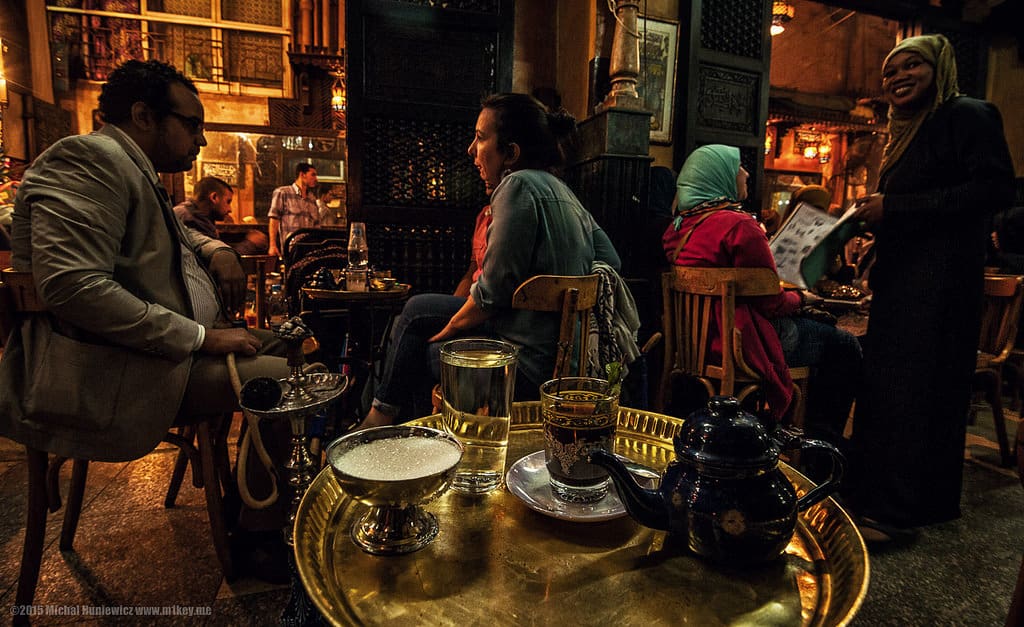
Moreover, Al Lord café is another spot that’s worth visiting. There, all the people appreciate Umm Kulthum, you can enjoy listening to her songs all night. With a remarkable statue of Umm Kulthum at the entrance and many muppets decorating the outdoor area of the café you’ll have your cup of coffee with an oriental taste. This brings us to an important part, food is a big part of any adventure, and there are many places there where you can try the nice taste of Egyptian traditional food.
If you’re fortunate enough, you’ll visit the area when it’s time for Al Hussien celebrations (Moulid of Hussein). It’s the celebrations of Imam Hussien’s (Prophet Muhammad’s grandson) birth. The celebrations are performed by Sufis every year where they dance, since, and perform traditional rituals which also include sparkling lights, drums, and religious singing.
There, you shouldn’t be using google maps, drop your smartphones and enjoy the discovery of the old streets. Go deep, stroll around the streets, discover new stalls and shops, find out about the old houses and buildings and take pictures as well. If by any chance you get lost, ask anyone around you about Al Muizz Street or Midan Al Hussien, they will help you get back there.
Al Ghouri Complex
Ever attended a tanoura or dervish whirling performance?! Not everybody knows about this, but you should definitely know and give this experience a try. Steps away from Al Muizz Street and Khan El Khalili market, stands Wekalet Al Ghouri (Ghouri Palace). It is the perfect place for you to enjoy a unique spiritual performance.
Wekalet Al Ghouri is a part of The Sultan Al Ghouri Complex. It was constructed during the 16th century (between the year 1503 and the year 1505) by king Al-Ashraf Abu el-Nasr Qansuh. The big complex is an Islamic architectural masterpiece. It combines a khanqah (a building for Sufi gatherings), mausoleum (burial chamber), sebil or sabil (a small building where water was provided freely to the public), mosque, and madrasa (school).
The complex is located at Al Fahhamin district at Al Muizz Street. And it’s a destination to both Egyptians and non-Egyptians who are interested in the secrets of the Egyptian heritage.
The Tanoura Performance
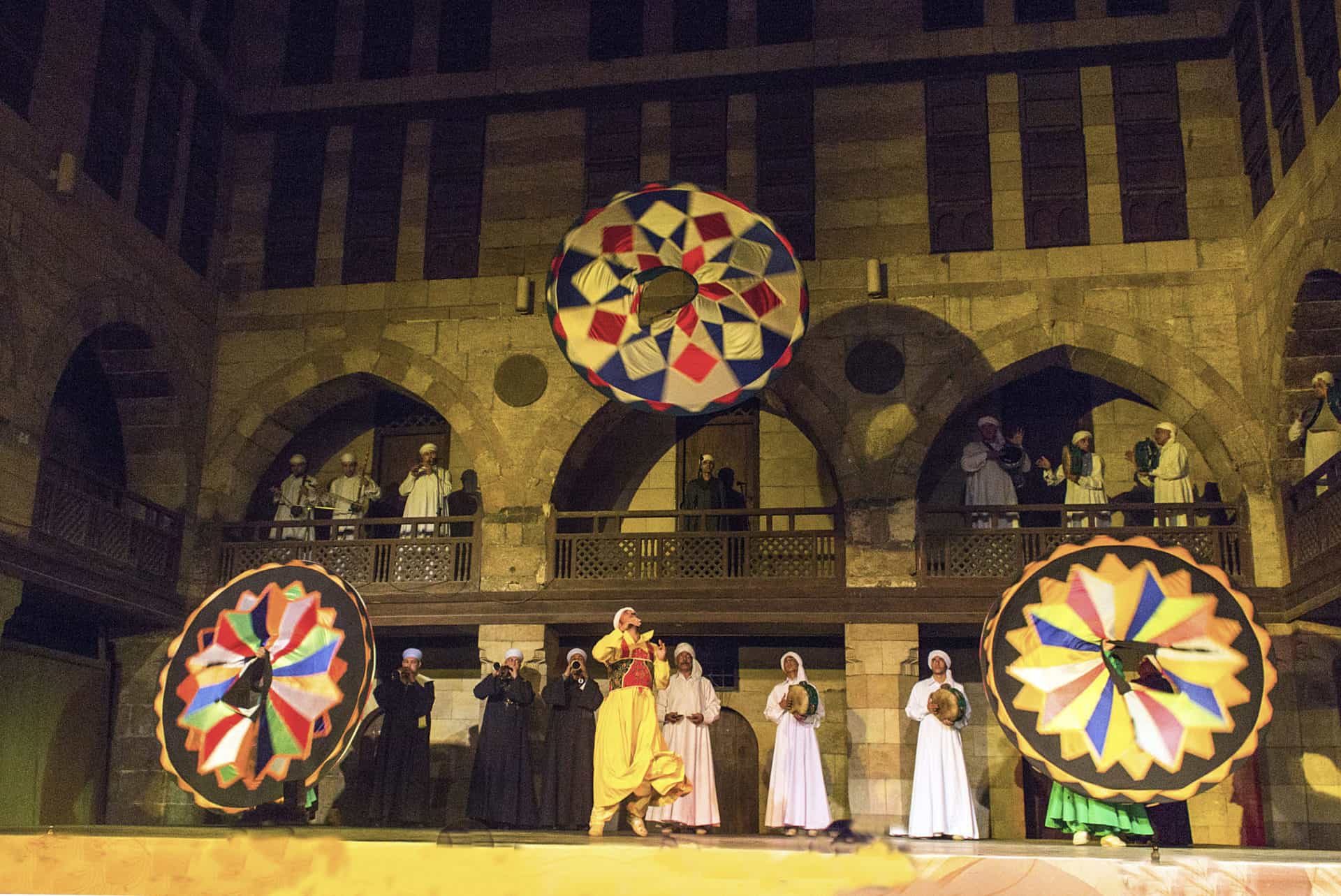
There, at the special Complex, the breath-taking Sufi Tanoura show takes place. Tanoura dance is a well-known Sufi spiritual performance (Sufi or dervish whirling). It’s famous in Turkey, but in Egypt, it has some variations. Especially with the colorful tanoura which the whirler wears for performance.
The word “tanoura” stands for a colorful skirt, each color of the tanoura has a Sufi representation. The beauty of the performance lies within the merging between music, chanting, devotion, and spirituality. It’s how the performer whirls and connects with God. If you’re interested in unraveling cultural mysteries, you’ll absolutely enjoy this.
The Tanoura show takes place every Saturday, Monday, and Wednesday at 7:30 pm. But the Wekala opens its doors at 6:30 pm. If you don’t want to miss your chance, go early. The earlier you go the easier you’ll find tickets and seats. Tickets cost around 30 Egyptian Pounds or maybe a bit more depending on the new prices. but either way, we guarantee you it’s going to be affordable and definitely worth it.
Bayt El-Suhaymi
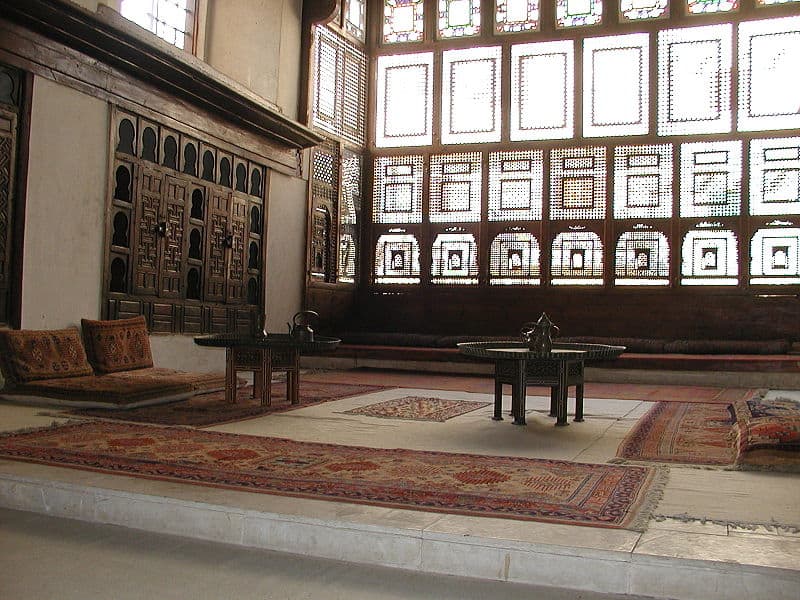
The name “Bayt Al Suhaymi” is translated as the House of Suhaymi. It is an old house museum that dates back to the Ottoman period. The house was initially constructed in the year 1468 by Abdel Wahab El Tablawy. El Tablawy built it in the luxurious and reputable area of old Cairo called Al Darb Al Asfar. In the year 1796, Sheikh Ahmed Al Suhaymi, a reputable man from a reputable family, bought the house. Sheikh Ahmed also purchased the surrounding houses to incorporate them into the original house. He later extended it into a bigger and more luxurious one.
The house is a great example of great architecture and design. It draws a picture of how a wealthy and luxurious life was in the 17th century. Bayt Al Suhaymi is constructed with a Sahn in the middle with a small garden, trees, and palms. The house has many staircase inlets, and around 30 rooms. During your tour in the house, you won’t help but notice the fascinating mashrabiyya windows, the beautiful marble floor, the elegant wooden furniture and the noticeable ceiling decorations which are still surviving till now.
Most noteworthy, Bayt Al Suhaymi is a landmark in the area of Al Muizz Street. Now, many cultural events and cultural movies take place there. The good news is that the house is open to the public, both Egyptians and non-Egyptians. Tickets cost around 35 Egyptian Pounds and around 15 Egyptian Pounds for students. You better add it to your places to visit list or you will miss a lot.
Sultan Barqouq Complex
Located in Al Muizz Street near Nasser Mohamed Mosque, lies the religious Complex of Sultan Al Zahir Barqouq. The complex consists of a mosque, madrasa (school) and khanqah (a building for Sufi gatherings). The complex is another masterpiece standing in the heart of Al Muizz Street drawing a picture of how great Islamic Cairo was. The architecture of the complex is very special and eye-catching.
The complex is mainly one of the most significant buildings standing in Al Muizz Street which date back to the Fatimid period. The complex was mainly built for the purpose of teaching the four Islamic schools of thoughts. The Sultan Barqouq chose one of the finest architects to build and design the complex between the year 1384 and the year 1386, and the choice was perfect. The beauty of the designs is still surviving up until now.
The Mosque has a one of a kind minaret which is different than the usual minarets’ designs known in the 14th century. As for the ceiling, it’s decorated with both blue and white marbles. At one side of the mosque, there is a rectangular complex which is known as the prayers area. And in the middle, there is a fountain for the people to wash or perform ablution before praying.
The School was built to accommodate more than 100 students who were willing to study the four Islamic schools of thoughts. The building also had rooms for teachers and spaces or stables for the horses. The design was very smart, the inlet of the school has a remarkably high, and spacious opening. Designers did that to let the sound echo which helped teachers to be heard when they were talking to the students.
The complex was designed and built by the architect Shihab Al Din Ahmed Ibn Muhamed Al Tuluni. The architect belonged to a family of architects of which he inherited the creativity and artistic taste. That’s of course in addition to the experience and knowledge. And as we already mentioned, the choice of the architect Tuluni was perfect. The complex became a distinctive construction among the other structures of this period.
Shihab Al Tuluni was a Christian and converted later to Islam. But as a sign of gratitude and respect, Sultan Barquq told Tuluni to create the front windows of the mosque with cross shapes. This doesn’t only draw a picture of how developed the art and architecture were in the old Islamic world, but it also gives you a glimpse of how classy and respectful the culture was.
Qalawun Complex
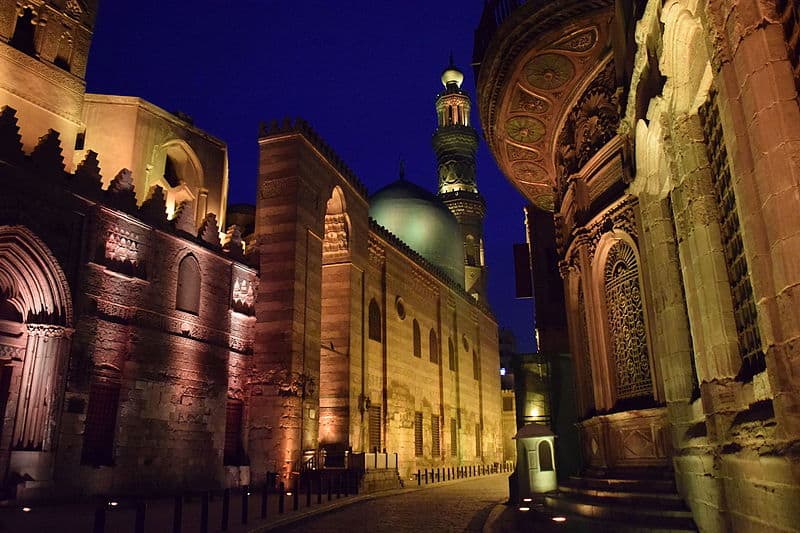
The Qalawun complex is another noticeable landmark which dates back to the Fatimid era in Al Muizz Street. The complex is actually big and includes a madrasa (school), a maristan (hospital) and a mausoleum. The complex was built by Sultan Al-Nasir Muhammad Ibn Qalawun around the year 1280. It’s worth mentioning that thirty of the mosques built during Sultan Al Nasir Muhammad Ibn Qalawun are still surviving till now.
The construction of the complex of Qalawun is considered as the beginning of a new stage which introduced the complexes to architectural design. The height of the façade is around 20 meters and it expands to 67 meters. It also has a view of the street.
Being the main reason why Sultan Qalawun constructed the complex, the maristan actually has an interesting story. It’s said that Sultan Qalawun once was on a trip to Al Sham (that’s the known Arab name for the area of Lebanon, Syria, Jordan and Palestine). When he was staying there he got really sick and his life was in danger. Doctors there cured him, and the medicines they used was brought Nur Al Din Mahmud Maristan in Damascus. So, the made a promise to God that if he was cured, he will build a huge maristan in Cairo.
Al Aqmar Mosque
Built in the year 1125, Al Aqmar Mosque is another prominent mosque which has been standing in Al Muizz Street for hundreds of years. The name “Al Aqmar” means moonlit in Arabic. The mosque is also called the Gray Mosque. Al Aqmar Mosque is an example to the small practical mosque built in the Fatimid era. Most noteworthy, the mosque is the first in Cairo to have decorations of the mosque include both inscriptions and geometric patterns.
Al-Hakim Mosque
At the side of Al Muizz street towards Bab Al Futuh stands Al Hakim Mosque. It is one of the top destinations in Al Muizz street. The mosque is named after, Al-Hakim bi-Amr Allah the Fatimid, a very famous ruler in the history of Islamic Cairo. People still know Al Hakim up until now for his weird laws. For example, he did forbid people from eating molokheya (a famous Egyptian traditional food). Even though, the weird laws are actually a part of his fame. But Al Hakim also was an important figure in the Fatimid era as he was the 6th Caliph and the 16th Ismaili Imam (a Shia belief/religion).
The mosque is one of the main mosques in Cairo, for its both historical significance and its important location. The minarets of the mosque are the most remarkable. The construction of the mosque is imitating the same style of Ibn Tulun Mosque. Visiting the mosque is very recommended; the setting is peaceful and relaxing. It’s a destination to both Egyptians and Non-Egyptians.
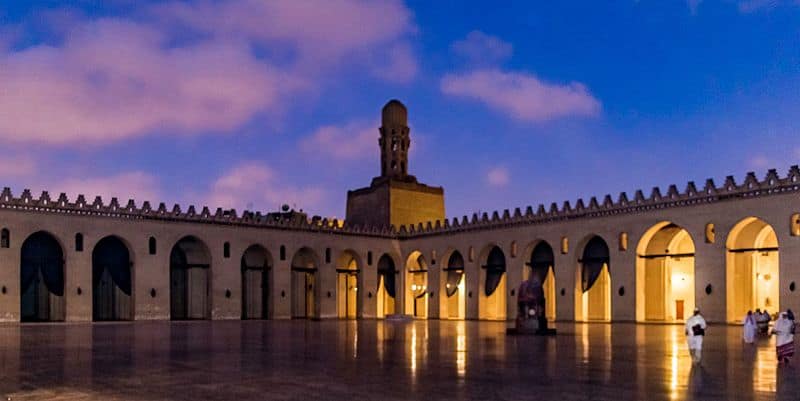
Ever Been There in Ramadan?
Visiting Al Muizz Street during the holy month is a whole new experience. It can be very crowded there, but that’s where you can feel the spirit of Ramadan. Visitors from around the world go there to enjoy the warmth of the place during the holy month. However, this makes it very difficult to find a spot for yourself. If you are one of those who want to go have Iftar (breakfast in Ramadan at sunset) or Sohoor (dinner in Ramadan must be before dawn time so that people start fasting) there then you better plan your visit.
If you are going for Iftar you have to go at least three or four hours earlier to find a proper spot for yourself. If you’re going for Sohoor or to spend some time at night, you still need to go at the beginning of the night as it won’t be easy to find a proper spot if you are late. It is for sure a difficult mission and you might think it is not worth it to go there with so much crowd around. But you need to know that with the spirit of the place and all the oriental environment with the historical setting, the experience is different and will definitely be worth it.
How to Go There?
Al Muizz Street and Khan Al Khalili are both located in the heart of Cairo, very close to Downtown which is the most vibrant area in the city. This makes it very easy for anyone to go there especially if you’re thinking about using public transportation. If you think it’s easier for you to use the metro (it’s very recommended to avoid the traffic especially during the rush hour). Then all you have to do is to reach Ataba metro station.
Once you’re there, you’ll be a few minutes away from Al Muizz street. So it’s your call now! you can take one of the small microbuses waiting in front of the station, take a taxi or just walk. Also, private cars have made it easier for everyone to move around the city without worrying about getting lost.
If you think it will be more convenient you have the choice to order an Uber, a Careem, or even take a cab, set your destination and leave the rest to the captain. Some other people prefer buses, so if you’re one of those you can take a bus from Abbaseya Square, Ramsis Square, or Tahrir Square. Go there and ask about the buses that go to Al Muizz Street.
Maybe we’ve listed above lots of places to visit and lots of activities to do when you go to Al Muizz Street. But there is still a lot to discover there. You can read about the area and even watch pictures and videos but it will never get you close enough to the real experience. If you’re currently in Egypt or planning your visit to Egypt soon add this open-air museum to your list. It’s totally worth it.
When you’re visiting, go there as early as possible to start your adventure early and get more time to discover new places and old buildings. Some of the places close around 3 pm, so that’s another reason why you should go early. Finish round one of your visit around lunch and go try some Egyptian traditional food from any of the nearby restaurants. Most of the places there serve Egyptian food.
After lunch, grab some coffee or any other drink of your desire (no alcohol). Then be prepared for the night activities. If you’re planning on attending the tanoura show at Wekalet Al Ghouri head there directly. Then maybe take some unique pictures.
It’s a whole different experience seeing a glimpse of how the Islamic civilization was. If you’re into discovering different cultures and go there, know for sure you’ll always want to come back. Your soul will connect to the spiritual and peaceful essence of the place.






